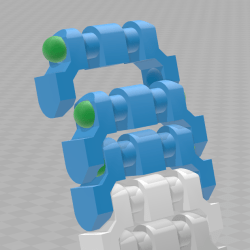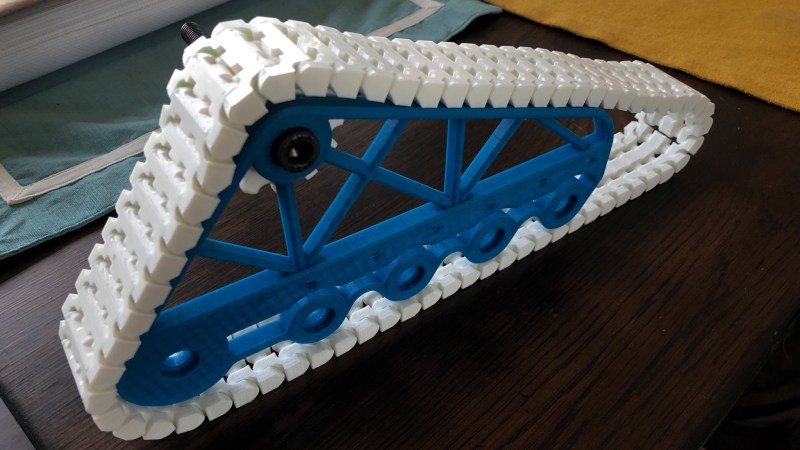3D printing is well-suited to cranking out tank tread designs, because the numerous and identical segments required are a great fit for 3D printing’s strengths. The only hitch is the need for fasteners between each of those segments, but [AlwynxJones] has a clever solution that uses plentiful hard plastic spheres (in the form of 6 mm airsoft BBs) as both a fastener and a hinge between each of the 3D printed track segments.
 Each segment has hollows made to snugly fit 6 mm BBs (shown as green in the image here) which serve both as fasteners and bearing surfaces. Assembly requires a bit of force to snap everything together, but [AlwynxJones] judges the result worth not having to bother with bolts, wires, or other makeshift fasteners.
Each segment has hollows made to snugly fit 6 mm BBs (shown as green in the image here) which serve both as fasteners and bearing surfaces. Assembly requires a bit of force to snap everything together, but [AlwynxJones] judges the result worth not having to bother with bolts, wires, or other makeshift fasteners.
Bolts or screws are one option for connecting segments, but those are heavy and can get expensive. Segments of printer filament have been successfully used in other tread designs, though that method requires added work in the form of either pins, or heat deforming the filament ends to form a kind of rivet. This design may be a work in progress, but it seems like a promising and clever approach.
[via Reddit]















I wonder why not actual metal BBs?
Probably personal preference, weight and differing size to be considered. Metal bbs are actually smaller (tried to put plastic airsoft bbs in a gun designed for metal ones) also, a jar of metal bbs weights considerably more than a plastic one.
My guesses are 1) cheaper 2) if it’s going to be driven by a motor, metal ones would add up to some significant weight?
I wonder why metal BBs?
Most metal BBs are 4.5mm (.177”)
Mike and I talked about this in the podcast, but didn’t come up with anything definitive.
Weight is obvious, but also the bigger size of the airsoft BBs makes it easier to print something with tolerances that will work. Smaller bearings will get caught in layers?
This post, along with all the myriad airsoft BB designs on Thingiverse, made me cave. I have 2,000 of them sitting on my desk just waiting for some free time. I’ll get back to you. :)
I use the filament for tracks up to inch and quarter. Brad nails after that. Tracks need adequate pins; if the track gets bound for any reason very large forces fall on those pins. I think dirt would make short work of these but that’s just my guess.
I see a potential watch strap there… In fact, print the face/body housing too. Always wanted this one to come to fruition: https://blog.tokyoflash.com/2012/09/24/abandon-watch-design-for-your-post-apocalyptic-survival/
I have an old Timex watch that would keep excellent time, but its plastic bezel and buttons broke off long ago.
It also used an unusual way to fasten the watch band, i.e. did not use spring pins.
I wonder if I’ll ever be able to design and print a replacement parts for it.
Very cool to see my design get posted to hackaday! Plastic was chosen over metal BBs because that’s what I had on hand. Also was much cheaper than metal ones, when I get a chance I will test the design with metal BBs.
I’m betting that steel BBs won’t be able to take as much tension before coming apart, due to their smaller diameter. I’d like to see someone print this ball bearing that uses 12 steel BBs. https://www.thingiverse.com/thing:1769802
Should be able to assemble it just like all metal ball bearings by pushing the center off to one side, loading the balls, evenly spreading them around then snapping the cage in. It’s a quick design just to test the feasibility of duplicating one method of ball bearing construction in 3D printing.
The cage is the key part, whether a snapped in plastic type or two metal parts that are riveted or spot welded together.
there is no where that i can see where the type of BB’s are specified, the only place that denotes that the creator used plastic BB’s is in a picture on the linked Thingiverse page.
What is the difference between plastic and metal 6mm BB’s other than their material and the associated physical differences due to the material.
The designer posted on reddit he said the mian reason for airsoft bbs is how cheap they are, $4 for 5k bbs.
If you know the length of the track you need, why not just print all the segments in one go, one inside another, so there’s no need to join them with any extra parts afterwards and they also cannot come apart accidentally, only by actually physically breaking?
I’d say that with the plastic BBs, the track can be easily popped back together if it breaks, whereas with an interconnected multi-segment print, an actual repair would be needed.
I work in a food processing plant and we use all kinds of plastic belts that you could call track like. We use nylon rods to, “lace the belts”, in holes that go all the through. Very durable and easy to repair.
For best cost the filament pin hinge, easier to assemble once fixture is made to hold pieces ot track, use bb at gate or multiple segments to adjust as if links in watch band. Use both.
BB is a size of lead shot. Why a BB gun is a BB gun is because that’s the size of lead shot the inventor of the BB gun had on hand. It could have been a B gun or a BBB gun. If he happened to have a bag of T size shot it would’ve been a T gun. http://i0.wp.com/joyofmusic.info/wp-content/uploads/2018/05/pistol-bullet-cartridge-size-chart.jpg
Thank you – it’s one of those terms I never bothered to look up.
I think I see an interesting solution to a piano-hinge I want to print…